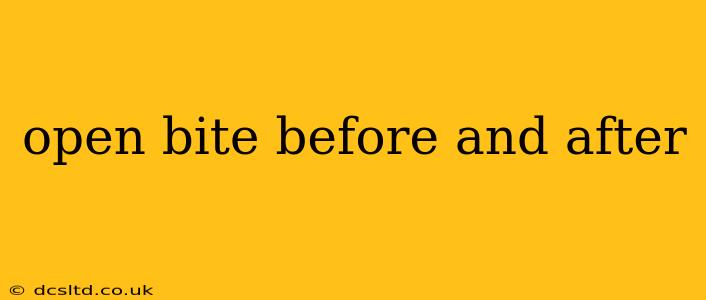An open bite is a malocclusion, or a misalignment of the teeth, where the upper and lower front teeth don't overlap when the mouth is closed. This leaves a noticeable gap or space between the incisors. This condition can affect both aesthetics and function, leading many to seek correction. Let's delve into the before-and-after transformations possible and the various treatment options available.
What Causes an Open Bite?
Understanding the underlying causes is crucial for effective treatment. Several factors can contribute to the development of an open bite:
- Thumb sucking or other oral habits: Prolonged thumb sucking, finger sucking, or pacifier use, especially past the age of 4, can exert significant pressure on the developing jaw, preventing proper tooth alignment.
- Tongue thrusting: The habit of constantly pushing the tongue against the front teeth can push them outwards, contributing to an open bite.
- Genetics: Family history of malocclusion can increase the likelihood of developing an open bite.
- Growth patterns: Abnormal growth patterns of the jawbones can also lead to this condition.
- Mouth breathing: Chronic mouth breathing can affect facial development and contribute to an open bite.
Open Bite Before & After: Real Transformations
The dramatic improvements achievable with modern orthodontic techniques are truly remarkable. Before-and-after photos often showcase a complete closure of the gap, resulting in a straighter, more aligned smile. These transformations not only enhance the aesthetic appeal but also improve chewing efficiency and overall oral health. However, the specifics of the transformation depend on the individual's case, the severity of the open bite, and the chosen treatment method. Results may vary.
How is an Open Bite Corrected?
Several treatment options are available depending on the severity and underlying cause of the open bite:
Orthodontic Treatment (Braces):
This is a common method, often using traditional metal braces or clear aligners like Invisalign. Braces gently reposition the teeth over time to close the gap and improve overall bite alignment. Treatment duration varies depending on the individual case.
Orthodontic Treatment with Surgery:
In severe cases, orthognathic surgery may be necessary. This involves surgical realignment of the jawbones to correct skeletal discrepancies contributing to the open bite. This is usually followed by orthodontic treatment to fine-tune the teeth alignment.
Myofunctional Therapy:
This focuses on correcting oral habits such as tongue thrusting and mouth breathing through exercises and therapy. This is often used in conjunction with other treatments, especially in younger patients.
What are the Long-Term Effects of an Uncorrected Open Bite?
Leaving an open bite untreated can have several long-term consequences:
- Increased risk of tooth decay and gum disease: The open bite makes it harder to clean the teeth thoroughly, increasing the risk of cavities and gum problems.
- TMJ disorders: Improper bite alignment can strain the temporomandibular joint (TMJ), leading to pain and dysfunction.
- Speech problems: In some cases, an open bite can affect speech clarity.
- Difficulty chewing: The inability to properly close the teeth can make chewing challenging.
How Long Does Open Bite Treatment Take?
The duration of treatment varies significantly depending on several factors including:
- Severity of the open bite: Mild cases may require less treatment time than severe cases.
- Age of the patient: Younger patients often respond more quickly to treatment.
- Treatment method chosen: Surgery generally requires more time than orthodontic treatment alone.
- Patient cooperation: Following the orthodontist's instructions diligently contributes to faster results.
Can an Open Bite Be Prevented?
While genetics play a role, some preventative measures can be taken:
- Early intervention for thumb sucking or other oral habits: Breaking these habits early can significantly reduce the risk of developing an open bite.
- Regular dental checkups: Early detection allows for timely intervention and prevents the condition from worsening.
- Myofunctional therapy: If oral habits are identified, early myofunctional therapy can be beneficial.
Are there any non-surgical options for correcting an open bite?
Yes, many open bites, particularly those less severe, can be successfully corrected with non-surgical orthodontic treatments like braces or Invisalign. However, the success of non-surgical treatment depends heavily on the underlying cause and severity of the open bite.
This information is intended for educational purposes only and should not be considered medical advice. Always consult with a qualified orthodontist or dentist for diagnosis and treatment planning. Before-and-after results can vary considerably based on individual circumstances.
